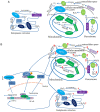The role of reactive oxygen species in cognitive impairment associated with sleep apnea
- PMID: 32934669
- PMCID: PMC7471880
- DOI: 10.3892/etm.2020.9132
The role of reactive oxygen species in cognitive impairment associated with sleep apnea
Abstract
Obstructive sleep apnea (OSA), a common breathing and sleeping disorder, is associated with a broad range of neurocognitive difficulties. Intermittent hypoxia (IH), one major characteristic of OSA, has been shown to impair learning and memory due to increased levels of reactive oxygen species (ROS). Under normal conditions, ROS are produced in low concentrations and act as signaling molecules in different processes. However, IH treatment leads to elevated ROS production via multiple pathways, including mitochondrial electron transport chain dysfunction and in particular complex I dysfunction, and induces oxidative tissue damage. Moreover, elevated ROS results in the accumulation of unfolded or misfolded proteins in the endoplasmic reticulum (ER) and increased activity of peroxisomes, such as NADPH oxidase, xanthine oxidase and phospholipase A2. Furthermore, oxidative tissue damage has been found in regions of the brains of patients with OSA, including the cortex and hippocampus, which are associated with memory and executive function. Furthermore, increased ROS levels in these regions of the brain induce damage via inflammation, apoptosis, ER stress and neuronal activity disturbance. The present review focuses on the mechanism of excessive ROS production in an OSA model and the relationship between ROS and cognitive impairment.
Keywords: endoplasmic reticulum; intermittent hypoxia; obstructive sleep apnea; reactive oxygen species; superoxide dismutase; unfolded protein response.
Copyright: © Xu et al.
Figures


Similar articles
-
Reactive oxygen species and the brain in sleep apnea.Respir Physiol Neurobiol. 2010 Dec 31;174(3):307-16. doi: 10.1016/j.resp.2010.09.001. Epub 2010 Sep 15. Respir Physiol Neurobiol. 2010. PMID: 20833273 Free PMC article. Review.
-
Critical Role of Endoplasmic Reticulum Stress in Chronic Intermittent Hypoxia-Induced Deficits in Synaptic Plasticity and Long-Term Memory.Antioxid Redox Signal. 2015 Sep 20;23(9):695-710. doi: 10.1089/ars.2014.6122. Epub 2015 May 8. Antioxid Redox Signal. 2015. PMID: 25843188 Free PMC article.
-
Oxidative stress in obstructive sleep apnea and intermittent hypoxia--revisited--the bad ugly and good: implications to the heart and brain.Sleep Med Rev. 2015 Apr;20:27-45. doi: 10.1016/j.smrv.2014.07.003. Epub 2014 Jul 24. Sleep Med Rev. 2015. PMID: 25155182 Review.
-
Protective effect of resveratrol against chronic intermittent hypoxia-induced spatial memory deficits, hippocampal oxidative DNA damage and increased p47Phox NADPH oxidase expression in young rats.Behav Brain Res. 2016 May 15;305:65-75. doi: 10.1016/j.bbr.2016.02.030. Epub 2016 Mar 3. Behav Brain Res. 2016. PMID: 26940604
-
Hippocampal impairments are associated with intermittent hypoxia of obstructive sleep apnea.Chin Med J (Engl). 2012 Feb;125(4):696-701. Chin Med J (Engl). 2012. PMID: 22490498
Cited by
-
Relationship between acute glucose variability and cognitive decline in type 2 diabetes: A systematic review and meta-analysis.PLoS One. 2023 Sep 1;18(9):e0289782. doi: 10.1371/journal.pone.0289782. eCollection 2023. PLoS One. 2023. PMID: 37656693 Free PMC article.
-
Unraveling the interplay between sleep, redox metabolism, and aging: implications for brain health and longevity.Front Aging. 2025 May 21;6:1605070. doi: 10.3389/fragi.2025.1605070. eCollection 2025. Front Aging. 2025. PMID: 40469623 Free PMC article. Review.
-
The oDGal Mouse: A Novel, Physiologically Relevant Rodent Model of Sporadic Alzheimer's Disease.Int J Mol Sci. 2023 Apr 9;24(8):6953. doi: 10.3390/ijms24086953. Int J Mol Sci. 2023. PMID: 37108119 Free PMC article.
-
Role of Oxidative Stress in the Occurrence and Development of Cognitive Dysfunction in Patients with Obstructive Sleep Apnea Syndrome.Mol Neurobiol. 2024 Aug;61(8):5083-5101. doi: 10.1007/s12035-023-03899-3. Epub 2023 Dec 30. Mol Neurobiol. 2024. PMID: 38159196 Review.
-
Can we obtain a reliable marker that shows the hypoxic burden in patients with sleep disordered breathing?Hypertens Res. 2023 Nov;46(11):2500-2502. doi: 10.1038/s41440-023-01425-5. Epub 2023 Sep 6. Hypertens Res. 2023. PMID: 37673960 No abstract available.
References
LinkOut - more resources
Full Text Sources
